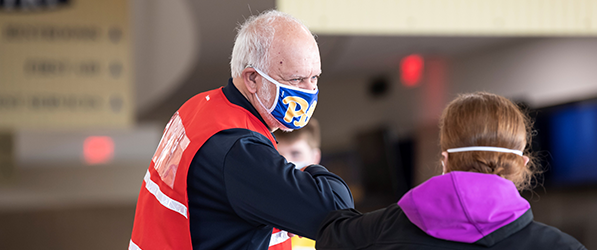Essential to Pitt’s front-line team, Environmental Health and Safety (EH&S) staff have gone above and beyond over the past 18 months, providing critical support areas across all of Pitt’s campuses. Examples include advising on cleaning protocols; conducting contact tracing when students, faculty and staff report COVID-19; gathering and maintaining data; partnering with the COVID Medical Response Office (CMRO) in multiple activities; overseeing a safe research environment; and sustaining a network of safety ambassadors.
It is the people of Pitt that made it all possible, committed to the safety of Pitt community members, and we thank the entire public safety team for their dedicated service and impact!
Moving into Action
Looking back to the winter of 2020, when the Emergency Operations Committee (EOC) convened for those first intensive meetings pertaining to a new virus that was impacting our world, Jay Frerotte, Assistant Vice Chancellor for EH&S and a 22-person EH&S team assessed the virus and began taking action, committed to keeping the Pitt community safe. In May 2020, the EH&S team transitioned back onto campus with guidance from Dr. Molly Stitt-Fischer, University Biosafety Officer, to provide a strong health and safety presence to support essential onsite workers and research groups.
“Eventually we learned that on any given week, there were 1,500 people on campus,” Frerotte said. “And since University members were on campus, our EH&S team felt that our presence was necessary to help those workers stay safe. Serving the University is a 365-day 24/7 job we are committed to in everything we do.”
When most students returned in August with safety protocols in place, the EH&S team doubled down on their efforts, with major roles in Building Safety Concierge Stations; the Pandemic Safety Ambassador Network; contact tracing; and identifying specialized disinfectants and cleaning supplies.
Taking Initiative
Following the first reported COVID-19 case on campus, Stefanie Coburn, Safety Coordinator, moved quickly to lead the University’s faculty and staff contact tracing efforts and collaborate with graduate students to support student contact tracing in partnership with CMRO and Healthcare Advisory Group.
“Stephanie stepped up and really served as a coordinator for all contact tracing, which operated from 9 a.m. to 9 p.m., 7 days a week from last summer through the end of the spring term,” Frerotte said. “That was a huge, heavy lift at the height of it all. We are grateful for Stephanie’s work to effectively lead this vital function that limited spread of the virus on our campuses.”
Providing Expertise
Throughout the pandemic response, real-time data became a key driver to provide actionable insights. Mark DiNardo, Hazardous Materials and Environmental Compliance Specialist, took the lead in data gathering to ensure University leadership was informed and updated.
“Mark DiNardo stepped up and kept data accurate and current seven days a week, providing reports and supporting requests for additional information.” Frerotte said. “This was a really instrumental piece throughout the pandemic, clearly understanding the data, trends and implications to support the University community.”
Specialty cleaning supplies were an integral component of safe virus control during the pandemic. EH&S staff reviewed and approved disinfectants and other cleaning products for bulk purchase and use across campus, partnering with Purchasing. During shortages of ready-to-use cleaning chemicals in 2020, EH&S diluted concentrated cleaning agents and distributed them to certain users.
Matt Sefanovski, Hazard Assessment Specialist, coordinated with Facilities Management to arrange specialized cleaning of identified areas where symptomatic persons had recently visited.
"It was very intense for a month or two when we were doing deep cleaning all over campus,” Frerotte said, “because there’s over 100 buildings.”
Collaborating Campus-wide
Teamwork is foundational to campus operations, and Heather Peffer of EH&S took the lead in developing the Pandemic Safety Ambassador Network across almost 200 departments on campus.
The Pandemic Safety Ambassador Network united 245 ambassadors for monthly calls and provided guidance, answered questions, and supported on-campus operations in line with Pitt’s health rules, working together across campuses, offices and departments to help in keeping Pitt community members safe.
Doug Noble, Research Environment Specialist took on a key coordination role in making sure all Building Safety Concierge stations stayed equipped with face coverings and cleaning supplies and provided training and education to everyone at the stations.
EH&S is a shining example of the collaborative spirit seen throughout Business and Operations, especially during the pandemic. We thank the hundreds of staff who worked tirelessly and stepped up to get through the pandemic, demonstrating their commitment to Pitt’s mission through their work. It is the people that make the Pitt difference!

